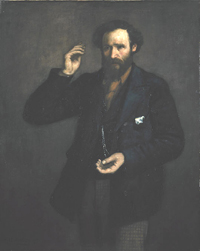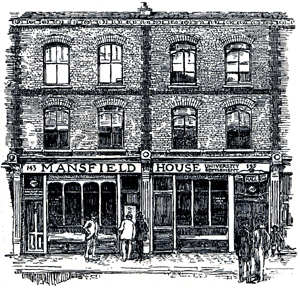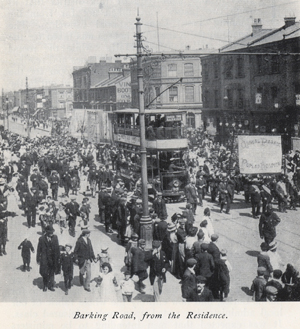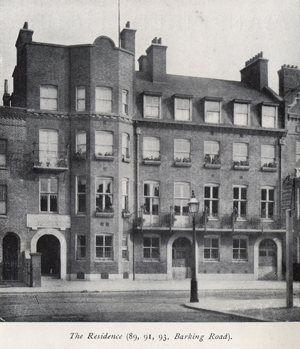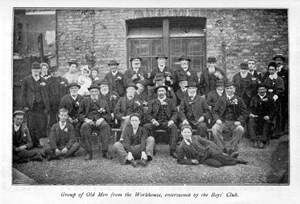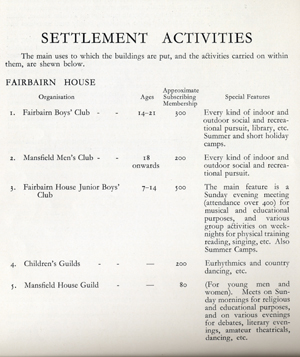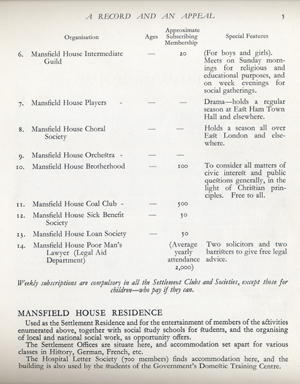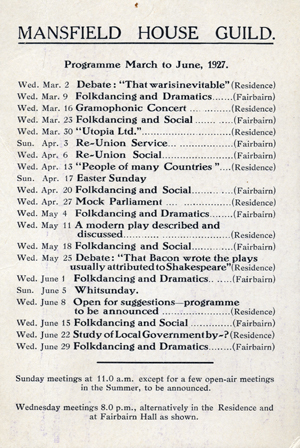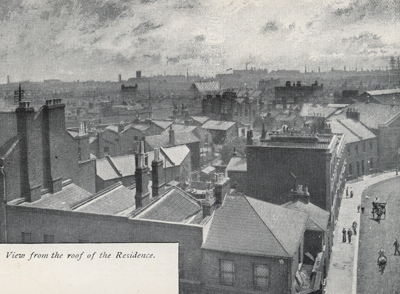|
In August and September 1889 local dock workers fought the Dockers’ Tanner strike, demanding to be paid sixpence an hour with two shillings a day minimum pay (10p in decimal currency), and fighting for the abolition of piece work (where dockers were paid separately for each task that they carried out). Although they attracted international support, the dockers failed in their attempts to get regular work, and men continued to have to wait outside the docks by the Connaught Tavern to see if they would be given work each day. A third of all local dockworkers were unsuccessful in obtaining work at any one time, and this created huge poverty. In 1892 the Scottish trade union activist Keir Hardie was invited to stand for election as an MP in West Ham South constituency, and became the first independent Labour MP in Britain. After losing his seat in 1895 he spent the next five years building up our modern Labour Party, which was inaugurated in 1900. At this point Keir Hardie became MP for Merthyr Tydfil and Aberdare, a seat he held until his death in 1915. A committed pacifist, Hardie was also prominent in campaigning for women’s right to vote, for self-rule for India, and against racial segregation in South Africa.
The Settlement movement
The Settlement movement was founded by the Reverend Samuel Barnett in the late 19th century on the basis that personal involvement was central to tackling poverty: giving money was not enough. Rather, educated people — the Settlements were usually linked to a university or public school — were encouraged to ‘settle’ in areas of social deprivation and to work alongside fellow residents to improve the quality of life for everyone. The East End of London was recognized as being a place where Settlements could play an important role, and Barnett opened the first, Toynbee Hall near Petticoat Lane in Whitechapel, in 1884. However, an earlier form of local Settlement was the Guild of St Alban the Martyr in Balaam Street on the border of Canning Town and Plaistow, an Anglo-Catholic settlement which moved ‘across the water’ in 1876. The ‘brethren’ held down paid jobs outside the church, but wore monastic dress in their own time. Politically radical (they supported the Liberal Party), they eventually lost their financial support and were forced to close in 1882. In 1884 Frederick William Newland, an Oxford graduate and Congregational Church Minister, then began a ministry in Canning Town. He invited pairs of students to work with him for two weeks at a time during their holidays, and this created a link between Canning Town and Oxford University. This led, on 21 May 1890, to the inauguration of the Mansfield Settlement at a meeting at Mansfield College, Oxford. Percy Alden, then a theology student, agreed to be the Settlement’s first warden — later he became Mayor of West Ham, then an MP, and he was eventually knighted in 1933.
The Mansfield House University Settlement opened in former shops at 143-147 Barking Road, the ‘residents’ building a hall behind which became known as Mansfield Hall. In 1897 they built a separate ‘residence’ in 89-93 Barking Road, and the Mansfield House Men’s Club moved into the original premises. Keir Hardie was a member of the Men’s Club, as were most of the local councillors. In 1892 one of the Settlement ‘residents’ founded a boys’ club in a small hall known as the Shipwrights Hall in Swanscombe Street. The club then moved to a disused pub, The Walmer Castle, before taking over the premises of Brennan’s Boxing Academy at 310-16 Barking Road in 1893. In 1900 this site was completely rebuilt as Fairbairn Hall, with a donation from the famous philanthropist J. Passmore Edwards. The club organized sports at a very high level, and boys went on to achieve international success in football, swimming, water polo and athletics.
For adults, Mansfield House operated an orchestral society, a choral society, a dramatic society (later supported by George Bernard Shaw), a gymnastic society, and rambling, cricket, football and cycling clubs. The Settlement opened The Brotherhood Society in 1892, and this later became the Civic Union. They also held weekly lectures and discussion groups, and many of the Settlement activists went on to play a part in local and national politics. All of this played a part in the fact that, in 1898, the first ever Labour council was elected in the borough of West Ham.
Mansfield Settlement provided a range of social services when state provision was virtually non-existent. One of the first volunteers, the barrister Frank Tillyard, ran a free legal clinic on one evening a week. This became known as ‘The Poor Man’s Lawyer’ and was widely copied by other Settlements. Meanwhile the Coal Club allowed residents to bulk-buy coal at wholesale prices and so to benefit from the savings. Other activities included a Sick Benefit Society to which workers could subscribe and then claim sick benefits if they became too ill to work; and a Penny Bank which enabled residents to build savings. The Settlement also ran clubs for hundreds of children every night, and provided them with cheap dinners. In 1903 the Settlement took over the Wave Lodging House at 234 Victoria Dock Road and ran it for as a ‘home for working men’ — essentially a hostel for sailors, casual dockworkers and homeless people searching for work. The Wave was known among sailors across the world as a place where a clean, cheap bed could be found. Since there were no local baths, The Wave also offered hot baths to all local residents, with a discount for members of any of the Mansfield House clubs.
The Canning Town Women’s Settlement, closely linked to Mansfield House, was founded in 1892 by F. W. Newland, pastor of the Canning Town Congregational Church, and was originally based at 461 Barking Road. The warden from 1892-1922 was Rebecca H. Cheetham, who became well-known in local public life. In 1899 the Women’s Settlement opened the Lees Hall, Barking Road as their main headquarters and offices (named after the philanthropist R. J. Lees who had funded it). Here they operated various clubs and societies for local girls and women, including an employment agency. They also provided a hospital among other services, later sending patients on to a convalescent home in Loughton which the Mansfield Settlement was able to buy in 1900. The Docklands Settlement had its roots in a school mission founded by the public school Malvern College in Worcestershire in 1895 to support unemployed young people in Canning Town. One of the pupils who volunteered there was Sir Reginald Kennedy-Cox, and after he graduated from Oxford he returned to Canning Town to found the Docklands Settlement. The Dockland Settlement’s facilities included a fully equipped dental surgery that operated for two days a week, a carpentry workshop and a full-time nursery school, as well as a well-known boxing club and children’s clubs. A number of other schools and churches ran smaller ‘missions’ and social projects in the area — Dickens’ ‘Londoners over the Border’ were regarded by the rest of the country as being the Londoners in the greatest need of support.
Christianity was at the core of much of Settlement activity, but Settlement ‘residents’ believed that actions were what were most important, not preaching. They also believed in working in solidarity as equals alongside poor people, rather than in providing charity. It was undoubtedly this attitude — as well as the dire need of the services that they provided — which meant that they attracted support and cooperation from across the community, including people from different religions and non-believers. It is hard to realize today just how radical the Settlement movement was in its time. At the turn of the century, the social order — reflected in the literature and records of the day — was fixed and rigid, and people from different social ‘classes’ rarely even met outside of work, let alone as equals. Whether people at the Settlements were debating, playing cricket or dancing, the very fact that they did this across class and cultural boundaries made their activities quietly revolutionary. Of course, tensions and divisions always remained within Canning Town. However, in the circumstances, the area was remarkably stable and cohesive.
The above images and others can be found in Newham Archives at Stratford Library, and should not be reproduced without their permission. Text © Ju Gosling aka ju90 2010
|

 Canning
Town quickly became known as an area where people were committed to
improving conditions for themselves and others. Most of the workers
at Beckton Gas Works lived in Canning Town, and in 1889 they succeeded
in getting union recognition and the right to work an eight-hour day
after strenuous campaigning. The union they founded became the General,
Municipal and Boilermakers’ Union (GMB), still in existence today.
Canning
Town quickly became known as an area where people were committed to
improving conditions for themselves and others. Most of the workers
at Beckton Gas Works lived in Canning Town, and in 1889 they succeeded
in getting union recognition and the right to work an eight-hour day
after strenuous campaigning. The union they founded became the General,
Municipal and Boilermakers’ Union (GMB), still in existence today.
